As e-commerce continues to evolve, the demand for sustainable packaging solutions grows more urgent by the day. Finding the delicate balance between product safety and sustainability has become a key concern for both businesses and consumers alike. That’s why we’ve outlined the three most effective eco-friendly packaging material types tailored specifically for the demands of e-commerce. Read on to learn more!
Corrugated Cardboard
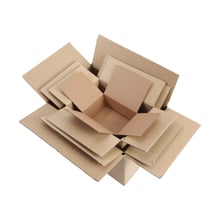
Durability
Corrugated cardboard is engineered with multiple layers of paperboard sandwiched between liners, ensuring both strength and rigidity. This design provides robust protection against impacts and compression forces, meaning products remain intact throughout the shipping process, even under challenging conditions such as rough handling or long-distance transportation.
Recyclability
Corrugated cardboard is highly recyclable, thanks to its predominantly paper-based composition. After use, cardboard packaging can be collected, sorted, and processed at recycling facilities, where it is pulped and transformed into new paper products or packaging materials. This closed-loop recycling system minimises the consumption of virgin materials and reduces the environmental footprint associated with cardboard production.
Environmental Impact
Compared to alternative packaging materials like plastic, corrugated cardboard boasts a lower environmental impact across its lifecycle. It’s derived from renewable resources, primarily wood fibre sourced from responsibly managed forests or recycled paper content. Additionally, the biodegradability of cardboard ensures that discarded packaging breaks down naturally over time, further mitigating its environmental footprint.
Contribution to Reducing Carbon Footprint
The carbon sequestered within the cellulose fibres of cardboard helps offset emissions associated with its production and disposal. Better still, the efficient recycling of cardboard diverts waste from landfills, where it would otherwise decompose anaerobically, releasing methane—a potent greenhouse gas—into the atmosphere.
Additional Paper-Based Materials
In addition to corrugated cardboard, sustainable packaging covers a variety of innovative paper-based materials, including those tailored for eco-void fill applications. These materials play crucial role in safeguarding products during shipping while minimising environmental impact. Here are some notable examples:
Recycled Paper Fillers
Durability
Recycled paper fillers, such as crumpled paper or shredded cardboard, offer excellent cushioning and void-fill properties, effectively protecting items from damage during transit.
Recyclability
Derived from post-consumer or post-industrial recycled paper, these fillers are fully recyclable and can be repurposed into new paper products or packaging materials.
Environmental Impact
By diverting waste paper from landfills and reducing the demand for virgin materials, recycled paper fillers contribute to resource conservation and waste reduction efforts.
Moulded Pulp Packaging
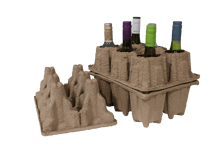
Durability
Moulded pulp packaging, made from recycled paper pulp, is moulded into various shapes to provide custom-fit cushioning for products. It offers robust protection against shocks and vibrations during shipping.
Recyclability
As a paper-based material, moulded pulp packaging is biodegradable and recyclable. It can be composted in industrial facilities or recycled along with other paper products.
Environmental Impact
Moulded pulp packaging represents a sustainable alternative to plastic-based protective packaging materials. It is derived from renewable resources and contributes to the circular economy by closing the loop on material usage.
Paper Air Cushions
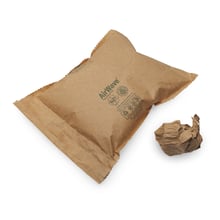
Durability
Paper air cushions, also known as air pillows, are inflated with compressed air to create lightweight and versatile void-fill packaging. Despite their lightweight nature, they provide effective cushioning and support.
Recyclability
Made from recyclable kraft paper, paper air cushions can be recycled along with other paper products or composted in appropriate facilities.
Environmental Impact
By replacing traditional plastic bubble wrap or foam peanuts with paper-based alternatives, such as air cushions, e-commerce businesses can significantly reduce their environmental footprint. Paper air cushions are biodegradable and do not contribute to plastic pollution in landfills or oceans.
Biodegradable and Compostable Plastics
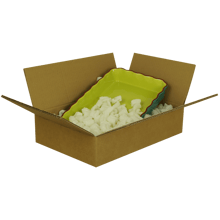
Durability
Biodegradable and compostable plastics exhibit comparable durability to conventional petroleum-based plastics, offering reliable protection for products during transit. These materials can withstand mechanical stress and environmental factors such as temperature fluctuations and moisture, ensuring that packaged items arrive at their destination intact and undamaged.
Compostability
Unlike traditional plastics, which remain in the environment for centuries, biodegradable and compostable plastics are designed to break down into organic compounds through microbial action in composting facilities or natural environments. This process is known as biodegradation, and it returns the material to the soil, where it can contribute valuable nutrients and support the growth of plants and microorganisms.
Recyclability
While challenges exist in recycling biodegradable and compostable plastics within existing waste management systems, advances are being made to build specialised recycling processes and infrastructure. Certain types of bioplastics can be mechanically or chemically recycled, enabling the recovery of valuable resources and the production of new materials with reduced environmental impact.
Environmental Impact
Biodegradable and compostable plastics offer significant environmental benefits compared to conventional plastics derived from fossil fuels. They harness renewable feedstocks such as plant-based polymers or biodegradable additives, helping to reduce our reliance on finite resources and reduce carbon emissions associated with plastic production and disposal.
Mushroom Packaging
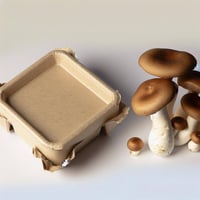
Durability
Also known as mycelium-based packaging, mushroom packaging maximises the natural properties of mycelium (the root structure of mushrooms) to create lightweight yet durable packaging. Mycelium contains remarkable shock-absorption capabilities, providing effective cushioning and protection for fragile items during transit. What’s more, the structure of mushroom packaging can be customised to fit the shape and size of various products, enhancing its protective qualities even further.
Compostability
At the end of its useful life, mushroom packaging can be composted in industrial composting facilities or even home composting setups. Mycelium-based materials readily biodegrade in composting environments, breaking down into organic matter that enriches the soil and supports plant growth. This composting process closes the loop on resource use, returning nutrients to the earth and reducing waste.
Recyclability
Mushroom packaging is inherently biodegradable, eliminating the need for traditional recycling processes that consume energy and resources. Unlike conventional packaging materials, which often end up in landfills or incinerators at the end of their lifecycle, mushroom packaging undergoes natural decomposition, leaving behind no harmful residues or pollutants.
Environmental Impact
Mushroom packaging is truly a sustainable alternative to conventional packaging materials, as it is derived from agricultural waste streams such as crop residues or sawdust, which are both abundant and renewable resources. The cultivation of mycelium requires minimal energy and water inputs compared to the production of synthetic plastics, further reducing its environmental footprint. Mycelium-based materials have also been shown to sequester carbon during their growth, meaning the selection of this material supports climate change mitigation efforts.
Sustainable Packaging Materials - Wrapped Up
Selecting the right packaging material is not merely a matter of ensuring product safety but also a commitment to long-term sustainable practices. The materials discussed – corrugated cardboard, biodegradable and compostable plastics, and mushroom packaging – offer a key balance of durability, recyclability, compostability, and environmental responsibility. In switching to eco-friendly alternatives, e-commerce businesses can both safeguard their products and showcase their drive to more environmentally viable practices in the long term, boosting their brand and serving stakeholders and customers alike.
Looking for inspiration for environmentally friendly packaging? We have a range of eco-performance products and sustainable options for virtually any application (including vegan-friendly packaging). Read our Sustainable Packaging Guide for insights into our dedication to sustainability and efficiency-driven processes.
For a comprehensive analysis of how Allpack can elevate your packaging's sustainability and reduce your environmental impact, reach out to us today. Contacting us is hassle-free: send a message, call 01543 396 700, or email sales@allpack.uk.com to make the switch to a sustainable packaging approach today.

